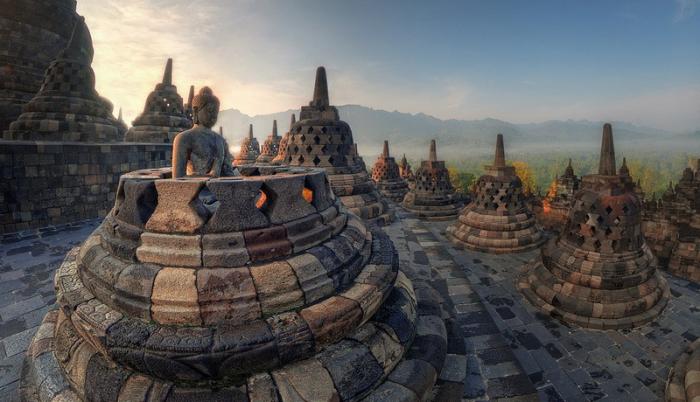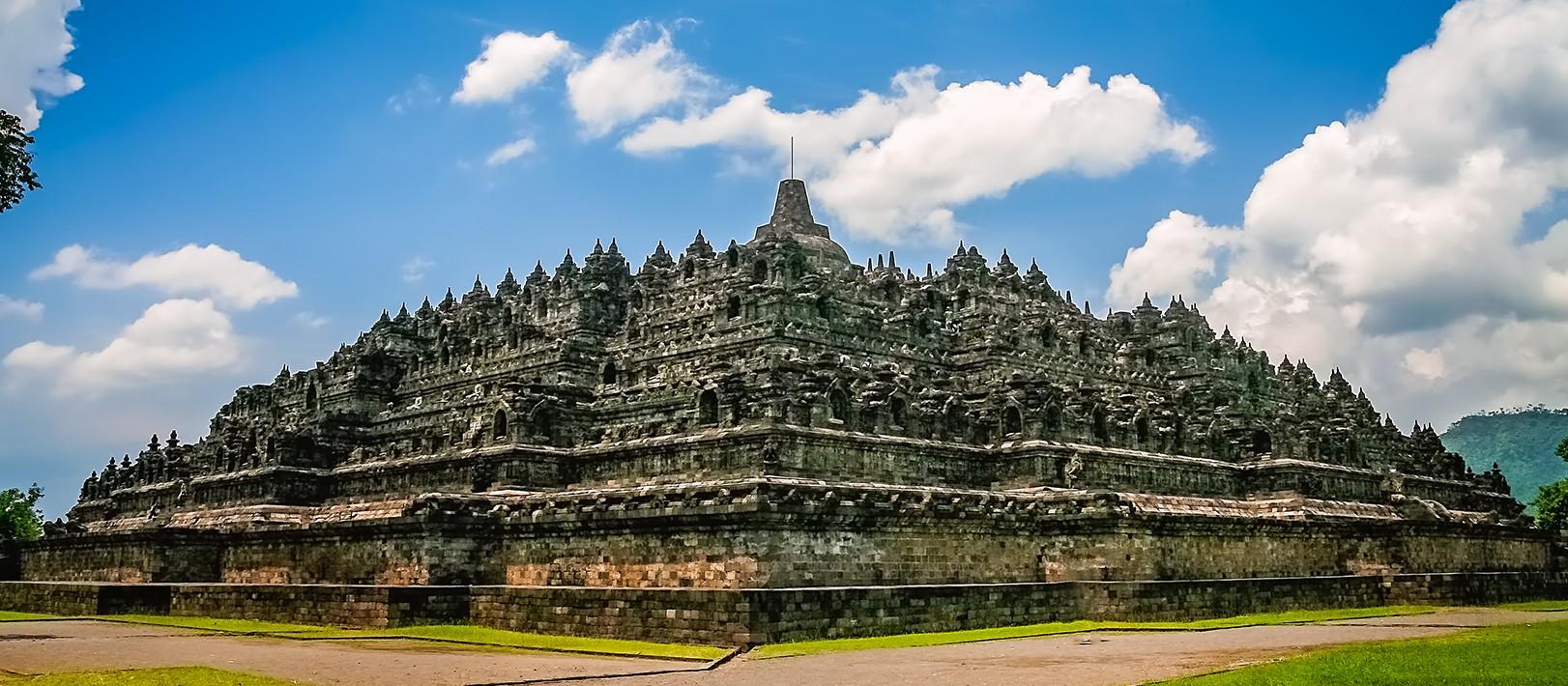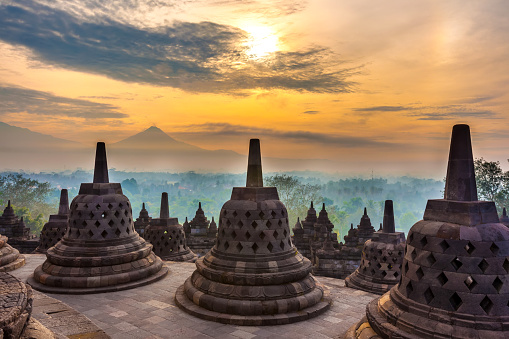1. A Brief History of Borobudur Temple
According to historical records, the initial construction of Borobudur Temple occurred in the 8th and 9th centuries around 800 AD during the reign of the Syailendra dynasty. The construction of Borobudur is predicted to take tens to hundreds of years until it was completely completed during the reign of King Samaratungga in 825. Although it was completed, there are no historical records explaining who built Borobudur Temple. The reason is, at that time Hinduism and Buddhism developed simultaneously on the island of Java. The Syailendra dynasty was recorded as a follower of Mahayana Buddhism while around Borobudur there were also followers of Shiva Hinduism.

The structure then changed due to the addition of square and circular steps. Then, Borobudur underwent the last change in the circular steps and the foundation was widened. The splendor of Borobudur had disappeared for centuries because it was buried under layers of soil and volcanic dust which were then overgrown with trees and bushes to resemble a hill. It is not known for sure why Borobudur was abandoned by its inhabitants at that time. Historical theories point to the eruption of Mount Merapi and the change of the population's beliefs from Buddhism to Islam. The return of Borobudur Temple's fame occurred during the time of Thomas Stamford Raffles when he served as Governor General on the island of Java in 1811. The rediscovery occurred when Raffles heard that there was a large building hidden deep in the forest near the village of Bumisegoro. Raffles then sent a Dutch engineer named Christian Cornelius to examine it. The spread of news of the rediscovery of Borobudur also became a disaster that caused damage in many places. Until the late 1960s the Indonesian government asked UNESCO for help to overcome the problems at Borobudur Temple. In the history of Borobudur Temple, its renovation took a long time and cost a lot of money until it was designated as a World Heritage Site by UNESCO in 1991.
2. The shape of Borobudur Temple
As the largest Buddhist temple in the world and the largest Buddhist monument in the world, according to the Ministry of Education and Culture, Borobudur Temple has a structure like a terraced pyramid that gets smaller as it goes up, with four stairs in each direction of the compass.
Borobudur Temple is 121.66 meters long, 121.38 meters wide, and 35.40 meters high. According to Buddhist philosophy, the structure of the levels of Borobudur Temple is an imitation of the universe of the wheel of life. There are three levels in the structure of Borobudur Temple, namely:
- Kamadhatu : The lowest part of the temple which symbolizes the lower realm, depicts human behavior that is still bound by worldly desires.
- Rupadhatu : The middle part of the temple which symbolizes the intermediate realm, depicts human behavior that has begun to leave worldly desires, but is still bound by the real world.
- Arupadhatu : The upper part of the temple which symbolizes the upper realm, depicts intangible elements and as a sign of levels that have abandoned worldly desires.
The stones at Borobudur Temple are predicted to come from the rivers around Borobudur with a total volume of around 55,000 cubic meters, equivalent to 2 million pieces of stone.
1. Function of Borobudur Temple
Apart from being a tourist attraction, Borobudur Temple now functions as a pilgrimage site for Buddhists around the world to guide humanity to leave worldly desires towards enlightenment and wisdom according to Buddhist teachings.
 On their journey, pilgrims walk through a series of corridors and stairs, witnessing 1,460 reliefs carved on the stone walls of the temple.
On their journey, pilgrims walk through a series of corridors and stairs, witnessing 1,460 reliefs carved on the stone walls of the temple.
2. Unique Facts about Borobudur Temple
Apart from the history and the Waisak holiday moments that attract international attention, Borobudur Temple holds a number of unique facts, including:

- There are 2,672 relief panels and 504 Buddha statues, making Borobudur the owner of the most complete and largest Buddha reliefs in the world.
- Theft of statues is rampant. Original Buddha head statues are often stolen to be sold in antique markets, collectors, and illegal markets. Of the 504 Buddha statues, many statues were found without heads.
- Borobudur Temple was once bombed. Two years after the 2nd restoration, on January 21, 1985, 13 bombs were placed by the perpetrators in a number of small stupas. 9 of the 13 bombs exploded and destroyed hundreds of stupa stone blocks. The bombings were related to radical understanding.
- The Dutch East Indies government handed over valuable statues to Thailand and England. The Dutch East Indies government at that time gave away a large number of temple artifacts for free as souvenirs for the arrival of the King of Thailand Chulalongkorn II.
- The Dutch East Indies government had set up a coffee shop at the top of the stupa when it was first discovered.
5 Myths and Mysteries of Borobudur Temple, Including Touching the Contents of the Stupa
This temple was built during the reign of the Syailendra dynasty around 800 AD. This temple is one of the largest Buddhist temples in the world.
Like other ancient buildings, Borobudur Temple also holds a number of myths and mysteries that are believed by the community. Here are some of them, summarizing various sources.

1. Kunto Bimo
A Buddha statue in the Borobudur Temple area is called Kunto Bimo. Myth says, anyone who can touch the statue inside this hollow stupa will get good luck.
Kunto Bimo itself comes from the word 'kunto' which in Javanese means 'ngento-ento' or request. While 'Bimo' is Bima, one of the Pandawa figures who has a never-give-up nature.
When combined, Kunto Bimo means a request with never giving up and hoping to get results.
However, this myth allegedly emerged thanks to the trickery of certain temple officials in the 1950s. The late archaeologist R. Soekmono, who led the temple restoration project in 1971-1983, said that the myth is not related to and is not taught in Buddhism.
Also, the activity of touching the inside of the stupa can have a negative impact on the sustainability of the temple building.
2. Singa Urung
When you are about to enter the temple complex, you will find two lion-shaped statues on the right and left of the temple stairs. These two lion statues are called Singa Urung.
There is a myth that if a couple passes between the two statues, their relationship will fail or 'urung' in Javanese.
3. Hidden reliefs
Visiting Borobudur Temple means visiting a historical site with stretches of reliefs along the temple walls.
Gathering information from various sources, there are two hidden reliefs that are rarely known to people. The reliefs are at the bottom and on the hidden foundation.
The reliefs are called Kamadhatu which consists of 160 reliefs from the Karmawibhangga Sutra or the law of cause and effect.

4. Mysterious architect
The existence of Borobudur itself is considered a miracle. The reason is, at that time there was no advanced technology to create a magnificent building like this. The stones were designed in such a way that they remained standing upright even without adhesives such as cement or iron reinforcement. Who was the architect or contractor behind this building? Apparently this is still a mystery. However, the community believes that Gunadarma was the genius behind the splendor of Borobudur.
The community also believes that Gunadarma has transformed into the Menoreh mountains which are not far from the temple.
5. Giant clock
The temple building is also believed to be a giant clock that relies on sunlight. The peak stupa or the largest stupa is used as a point to mark the hour.
When exposed to sunlight, the peak of the stupa will cast a shadow and fall on one of the stupas on the lower level.
Not only that, it turns out that the architect was able to calculate the direction of the wind precisely and applied it to the construction of the temple. Borobudur Temple has become a very precise direction indicator.

